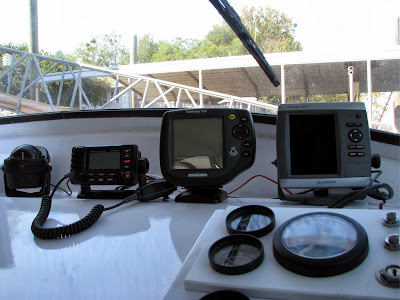Please recall that on her last voyage Ms. Bettencourt's old diesel began to exhibit some troubling temperature rises. After checking the usual suspects, it seemed to me that the problem was either a disintegrating cooling water pump impeller or a clogged heat exchanger.
I removed the end cover from the pump (if you click to enlarge this photo, it's that doohicky left center that says "Oberdorfer" on it).
Anyway, the impeller looked OK, so I moved on to remove the heat exchanger. This revealed that front end of this engine really needs a cleanup, so here's an obvious project expansion.
With the heat exchanger on the bench with its end caps off, I looked down the barrel expecting to find at least some clogged passages.
Actually, it didn't look too bad. A length of wire moved through the small passages easily. There was some sand, and, surprise, a piece of water pump impeller. This clue will lead me to look under the Oberdorfer cover yet again, this time more carefully.
I have ordered new end caps and gaskets for the heat exchanger and they won't be here until Wednesday, so there's time for a more thorough heat exchanger cleaning;.
The heat exchanger goes into a tank of vinegar for a long soak. Helpful hint: old plastic tool boxes are often big enough to accommodate strange shaped parts for soaking.
Meanwhile, it's time to check the sacrificial anode. The take-out part does not measure up.
The zinc on the left has obviously been doing its job and will be replaced by the spare on the right.
Those discs at the top of the photo are the end cap gaskets, which will also be replaced.
The black rubber sliver in the foreground is the impeller piece found in the cooling water intake end of the heat exchanger.
After two days in the vinegar bath, the heat exchanger comes out looking relatively shiny.
The vinegar turned black during the soak and I found a lot of grit and small black flakes in the fluid.
I blasted both the large and small passages out with the garden hose and got only clean water out the ends. Perhaps all this will improve the heat exchanger's performance. But, I doubt that the amount of stuff I cleaned out of this heat exchanger will explain the 4-5F engine temperature creep that started this whole project.
Incidentally, a further explanation of the anatomy of this device might be in order. Here's how it works: The engine coolant (antifreeze) goes into one of the big elbows shown in this picture, through a large central tube, then back to the engine via the other elbow.
Cooling water, supplied by the Oberdorfer pump, goes in and out of the small inlets at the bottom of this photo. The water circulates through many smaller tubes around the central tube, then goes out through a hose that connects to the exhaust elbow at the other end of the engine. In this photo, the sacrificial anode screws into the fitting at the top right of the cylinder.
Anyway, the story isn't over yet, because I am not convinced the cause of the problem has been found. While I am awaiting parts, I'll give the raw water pump impeller a closer look, and probably replace it. And since I have the whole thing apart, I'll replace all the hoses and hose clamps and de-grease and clean the front of the engine.
At this point, I can't imagine how this project could snowball any larger, but that doesn't mean it won't. Please check back later for a report on results.

















































